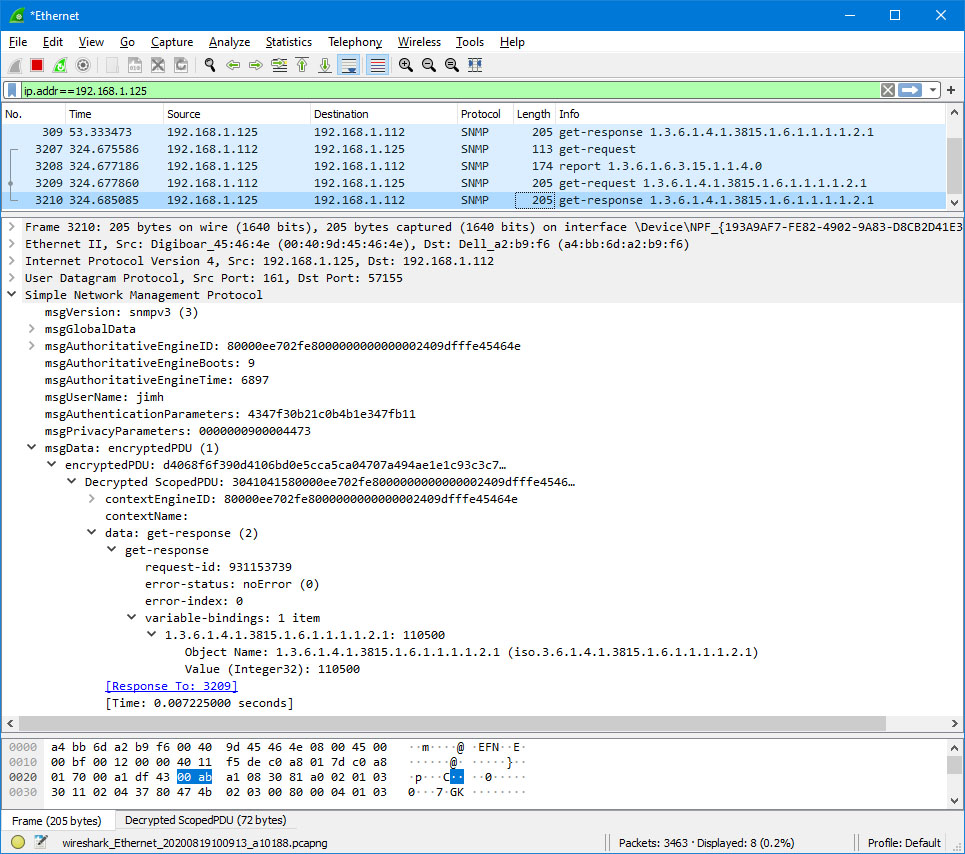
 |
You will find message and error counters listed on the Error Counts page under RTU Data. If the ValuPoint is configured as Modbus master, then the Error Counts page will list counts by slave address. If the ValuPoint is configured as Modbus slave, then errors show up on the first line (Unit # 1) regardless of what address the ValuPoint is configured to be.
The Errors: Read Maps and Errors: Write Maps pages will tell you exactly which maps are getting errors when the ValuPoint is configured as Modbus Master.
The most frequent problem is "no response" or timeout. This means the master and slave are not connecting for any of several possible reasons: (a) There is a wiring problem; (b) Port parameters are not configured the same (baud rate, etc); (c) Master's timeout setting is too short.
When it comes to wiring, remember that RS-458 is NOT truly a 2-wire interface as it is commonly referred to. Refer to the RS-485 FAQ under Support at csimn.com if you have questions or concerns about wiring.
If you are getting CRC errors, that is almost always a wiring problem, but can be a port problem such as mismatched parity setting. A CRC error will not be caused by incorrect configuration of a Read Map or Write Map.
If you are getting exception errors, that is somewhat good news - it means that at least you are successfully communicating. An exception error most often means the master is asking the slave for a register that the slave does not have. If the ValuPoint is configured as Modbus master, this means the Read Map or Write Map is not configured correctly.
You will find message and error counters listed on the Error Counts page under TCP Data for Modbus client activity. Counts will be listed by device number for those devices found on the TCP Setup Devices page.
The Errors: Read Maps and Errors: Write Maps pages will tell you exactly which maps are getting errors when the ValuPointr is operating as Modbus TCP client (master).
The most frequent problem is "no response" or timeout. The most common cause of this problem for Modbus TCP is a network configuration problem, such as incorrect IP address or IP address that cannot be reached as configured. The problem sometimes lies outside the ValuPoint and may require consulting with the IT personnel responsible for the network if on a large network.
If you are getting exception errors, that is somewhat good news - it means that at least you are successfully communicating. An exception error most often means the master is asking the slave for a register that the slave does not have. If the ValuPoint is configured as Modbus master, this means the Read Map or Write Map is not configured correctly.
Modbus Register Types
The types of registers referenced in Modbus devices include the following:
• Coil (Discrete Output)
• Discrete Input
• Input Register
• Holding Register
Whether a particular device includes all of these register types is up to the manufacturer. It is very common to find all I/O mapped to holding registers only. Coils are 1-bit registers, are used to control discrete outputs, and may be read or written. Discrete Inputs are 1-bit registers used as inputs, and may only be read. Input registers are 16-bit registers used for input, and may only be read. Holding registers are the most universal 16-bit register, may be read or written, and may be used for a variety of things including inputs, outputs, configuration data, or any requirement for "holding" data.
Modbus Function Codes
Modbus protocol defines several function codes for accessing Modbus registers. There are four different data blocks defined by Modbus, and the addresses or register numbers in each of those overlap. Therefore, a complete definition of where to find a piece of data requires both the address (or register number) and function code (or register type).
The function codes most commonly recognized by Modbus devices are indicated in the table below. This is only a subset of the codes available - several of the codes have special applications that most often do not apply.
| Function Code | Register Type |
| 1 | Read Coil |
| 2 | Read Discrete Input |
| 3 | Read Holding Registers |
| 4 | Read Input Registers |
| 5 | Write Single Coil |
| 6 | Write Single Holding Register |
| 15 | Write Multiple Coils |
| 16 | Write Multiple Holding Registers |
Modbus Exception (error) Codes
When a Modbus slave recognizes a packet, but determines that there is an error in the request, it will return an exception code reply instead of a data reply. The exception reply consists of the slave address or unit number, a copy of the function code with the high bit set, and an exception code. If the function code was 3, for example, the function code in the exception reply will be 0x83. The exception codes will normally be one of the following:
|
1
|
Illegal Function | The function code received in the query is not recognized by the slave or is not allowed by the slave. |
|
2
|
Illegal Data Address | The data address (register number) received in the query is not an allowed address for the slave, i.e., the register does not exist. If multiple registers were requested, at least one was not permitted. |
|
3
|
Illegal Data Value | The value contained in the query's data field is not acceptable to the slave. |
Modicon convention notation for Modbus registers
Modbus was originally developed by Gould-Modicon, which is presently Schneider Electric. The notation originally used by Modicon is still often used today, even though considered obsolete by present Modbus standards. The advantage in using the Modicon notation is that two pieces of information are included in a single number: (a) The register type; (b) The register number. A register number offset defines the type.
The types of registers referenced in Modbus devices, and supported by ValuPoints, include the following:
• Coil (Discrete Output)
• Discrete Input
• Input Register
• Holding Register
Valid address ranges as originally defined for Modbus were 0 to 9999 for each of the above register types. Valid ranges allowed in the current specification are 0 to 65,535. The address range applies to each type of register, and one needs to look at the function code in the Modbus message packet to determine what register type is being referenced. The Modicon convention uses the first digit of a register reference to identify the register type.
Register types and reference ranges recognized by ValuPoints are as follows:
0x = Coil = 00001-09999
1x = Discrete Input = 10001-19999
3x = Input Register = 30001-39999
4x = Holding Register = 40001-49999
Translating references to addresses, reference 40001 selects the holding register at address 0000, most often referred to as holding register number 1. The reference 40001 will appear in documentation using Modicon notation, but ValuPoints require specifying "holding register" and entering that register number as just "1".
On occasion, it was necessary to access more than 10,000 of a register type using Modicon notation. Based on the original convention, there is another defacto standard that looks very similar. Additional register types and reference ranges recognized by ValuPoints are as follows:
0x = Coil = 000001-065535
1x = Discrete Input = 100001-165535
3x = Input Register = 300001-365535
4x = Holding Register = 400001-465535
If registers are 16-bits, how does one read Floating Point or 32-bit data?
Modbus protocol defines a holding register as 16 bits wide; however, there is a widely used defacto standard for reading and writing data wider than 16 bits. The most common are IEEE 754 floating point, and 32-bit integer. The convention may also be extended to double precision floating point and 64-bit integer data.
The wide data simply consists of two consecutive "registers" treated as a single wide register. Floating point in 32-bit IEEE 754 standard, and 32-bit integer data, are widely used. Although the convention of register pairs is widely recognized, agreement on whether the high order or low order register should come first is not standardized. For this reason, many devices, including all Control Solutions devices, support register "swapping". This means you simply check the "swapped" option (aka "High reg first" in some devices) if the other device treats wide data in the opposite order relative to Control Solutions default order.
Control Solutions Modbus products all default to placing the high order register first, or in the lower numbered register. This is known as "big endian", and is consistent with Modbus protocol which is by definition big endian.
What does notation like 40001:7 mean?
This is a commonly used notation for referencing individual bits in a register. This particular example, 40001:7, references (Modicon) register 40001, bit 7. Bits are generally numbered starting at bit 0, which is the least significant or right most bit in the field of 16 bits found in a Modbus register.
How do I read individual bits in a register?
Documentation tends to be slightly different for every Modbus device. But if your device packs multiple bits into a single holding register, the documentation will note up to 16 different items found at the same register number or address. The bits may be identified with “Bn” or “Dn” or just “bit n”. Most of the time, the least significant bit will be called bit 0 and the most significant will be bit 15. It is possible you could find reference to bit 1 through bit 16, in which case just subtract one from the number to reference the table below.
You cannot read just one bit from a holding register. There is no way to do that - Modbus protocol simply does not provide that function. You must read all 16 bits, and then test the individual bit you are interested in for true or false (1 or 0). ValuPoints provide an automatic way of doing that by including a "mask" in each register map or rule. Each time the register is read, the mask will be logically AND-ed with the data from the register, and the result will be right justified to yield a 1 or 0 based on whether the selected bit was 1 or 0. ValuPoints provide optimization when successive read maps or rules are selecting different bits from the same register. The Modbus register will be read from the slave once, and the 16-bit data will be shared with successive maps or rules, with each map or rule selecting its bit of interest.
The bit mask shown in the expanded form of the ValuPoint RTU read map is a 4 digit hexadecimal (16 bit) value used to mask out one or more bits in a register. The selected bits will be right justified, so a single bit regardless of where positioned in the source register will be stored locally as 0 or 1. The hex bit mask values would be as follows:
B0/D0/bit 0 mask = 0001
B1/D1/bit 1 mask = 0002
B2/D2/bit 2 mask = 0004
B3/D3/bit 3 mask = 0008
B4/D4/bit 4 mask = 0010
B5/D5/bit 5 mask = 0020
B6/D6/bit 6 mask = 0040
B7/D7/bit 7 mask = 0080
B8/D8/bit 8 mask = 0100
B9/D9/bit 9 mask = 0200
B10/D10/bit 10 mask = 0400
B11/D11/bit 11 mask = 0800
B12/D12/bit 12 mask = 1000
B13/D13/bit 13 mask = 2000
B14/D14/bit 14 mask = 4000
B15/D15/bit 15 mask = 8000
Some Modbus devices also back two 8-bit values into a single 16-bit register. The two values will typically be documented as “high byte” and “low byte” or simply have “H” and “L” indicated. If you run into this scenario, the masking for bytes is as follows:
High byte mask = FF00
Low byte mask = 00FF
When the mask value in a ValuPoint is more than just one bit, the mask is still logically AND-ed with the data from the Modbus slave, and the entire resulting value is right justified to produce an integer value of less than the original bit width of the original register.
There have been a few instances of documenting packed bits in a 32-bit register. Although Modbus protocol is strictly 16-bit registers, some implementations force you to read pairs of registers. If your device documents 32 packed bits, then you would insert 0000 in front of each mask above, and the remainder of the list would be as follows:
B16/D16/bit 16 mask = 00010000
B17/D17/bit 17 mask = 00020000
B18/D18/bit 18 mask = 00040000
B19/D19/bit 19 mask = 00080000
B20/D20/bit 20 mask = 00100000
B21/D21/bit 21 mask = 00200000
B22/D22/bit 22 mask = 00400000
B23/D23/bit 23 mask = 00800000
B24/D24/bit 24 mask = 01000000
B25/D25/bit 25 mask = 02000000
B26/D26/bit 26 mask = 04000000
B27/D27/bit 27 mask = 08000000
B28/D28/bit 28 mask = 10000000
B29/D29/bit 29 mask = 20000000
B30/D30/bit 30 mask = 40000000
B31/D31/bit 31 mask = 80000000
Deciphering Modbus Documentation
Documentation for Modbus is not well standardized. Actually there is a standard, but not well followed when it comes to documentation. You will have to do one or more of the following to decipher which register a manufacturer is really referring to:
a) Look for the register description, such as holding register, coil, etc. If the documentation says #1, and tells you they are holding registers, then you have holding register #1. You also have user friendly documentation.
b) Look at the numbers themselves. If you see the first register on the list having a number 40001, that really tells you register #1, and it is a holding register. This form of notation is often referred to as the old Modicon convention.
c) Look for a definition of function codes to be used. If you see a register #1, along with notation telling you to use function codes 3 and 16, that also tells you it is holding register #1.
IMPORTANT: Register 1 is address 0. Read on…
d) Do the numbers in your documentation refer to the register number or address? Register #1 is address zero. If it is not clear whether your documentation refers to register or address, and you are not getting the expected result, try plus or minus one for register number. All Control Solutions products refer to register numbers in configuration software or web pages. However, some manufacturers document their devices showing address, not register numbers. When you have addresses, you must add one when entering that register into configuration software from Control Solutions.
Can I put 2 Valupoints on the same Modbus network?
You can not have more than one Master on a Modbus RTU (RS-485) network. Therefore, if the ValuPoint is to be configured as the Master, you can only have 1 ValuPoint. You cannot use multiple ValuPoints to read more points from the same Modbus slave device.Multiple ValuPoints configured as slaves can reside on the same Modbus RS-485 network.
If you are using RS-232 devices, you can have only two devices total, regardless of how they are configured. RS-232 is not multi-drop.
How many devices can I have on a Modbus RTU network?
Logically you can address over 250 devices; however, the RS-485 transceivers are not capable of physically driving that many devices. Modbus protocol states that the limit is 32 devices, and most RS-485 transceivers will agree with this. Only if all devices on the network have low load transceivers can you have more than 32 devices.Assuming you have IP addresses configured correctly and the SNMP ports are open through any routers and firewalls between devices, the most common cause of not communicating is a mismatching community string for SNMPv2 or incorrect user credentials for SNMPv3. Without the correct credentials, most devices will simply ignore the request, making it look as if there is no connection when in fact there is nothing wrong with the connection.
Another common oversight is that when adding local registers to the local MIB, you need to click the Reload SNMP button at the bottom of the Local MIB pages to cause SNMP to reload its internal tables with the new configuration you just entered. The Local MIB pages are effectively a list of instructions for loading the SNMP MIB, but the MIB is not automatically rebuilt every time you add another line to the Local MIB pages. To reload the MIB according to the list of instructions you provided on the Local MIB web pages, you need to click Reload SNMP. (Note: The Reload SNMP button is found on multiple pages, but they all perform the same function and any of the Reload SNMP buttons will reload all branches of the MIB.)
Two of the most useful tools in trouble shooting SNMP are Wireshark and a MIB browser. An example follows.
There are no particular hardware requirements regarding the PC you run Wireshark on. Basically anything running any version of Windows can run Wireshark. There are also Linux and Mac versions.
The "hardware requirement" that is of most concern is the means of connecting to the network. We typically just connect everything Ethernet to a switch and don't worry about it. However, switches are really unmanaged routers, and they filter traffic. Therefore, your PC will not see traffic passing back and forth between two other devices that are not the PC. In order to see that network traffic using Wireshark, you need to come up with the right kind of network connection.
If your PC itself is one end of the network conversation you wish to capture, for example when running the MIB Browser, then Wireshark will capture all network traffic to and from the PC however connected. It is when your PC wants to simply "eavesdrop" that you run into problems with the network switch.
A while back, 10BaseT hubs were common. A 10BaseT hub is not as smart as a switch and does not filter traffic. If you have an old 10BaseT hub collecting dust somewhere, you now have a new use for it. It will let Wireshark see all traffic from the PC that goes between any other devices connected to that 10BaseT hub. Beware of devices that call themselves "hubs" but support 100BaseT connections. These are switches.
Since manufacturers of hubs decided nobody should have a use for them anymore, they are generally out of production. Finding a 10BaseT hub for sale is not easy (try eBay). But there are other alternatives.
One means of monitoring network traffic is to get a managed switch that supports "port mirroring". One such device we have tested is the TP-LINK model TL-SG105E. Setting it up requires utility software (provided with the switch) and takes a little effort to get configured. But once configured, it works well without any further monkeying around. And it is inexpensive.
The other means of monitoring traffic is with the use of a device made specifically for use with Wireshark. The "SharkTap" provides two connections for the network pass-through, and a third "tap" connection where you connect your PC running Wireshark. There is no configuration required. It is the simplest way to monitor network traffic, and it is a current production item available on Amazon (as of 2020).
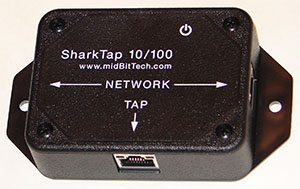
If you use Wireshark to capture a Get request in SNMPv3 with privacy configured, Wireshark won't be able to display anything meaningful until you provide Wireshark with some credentials.
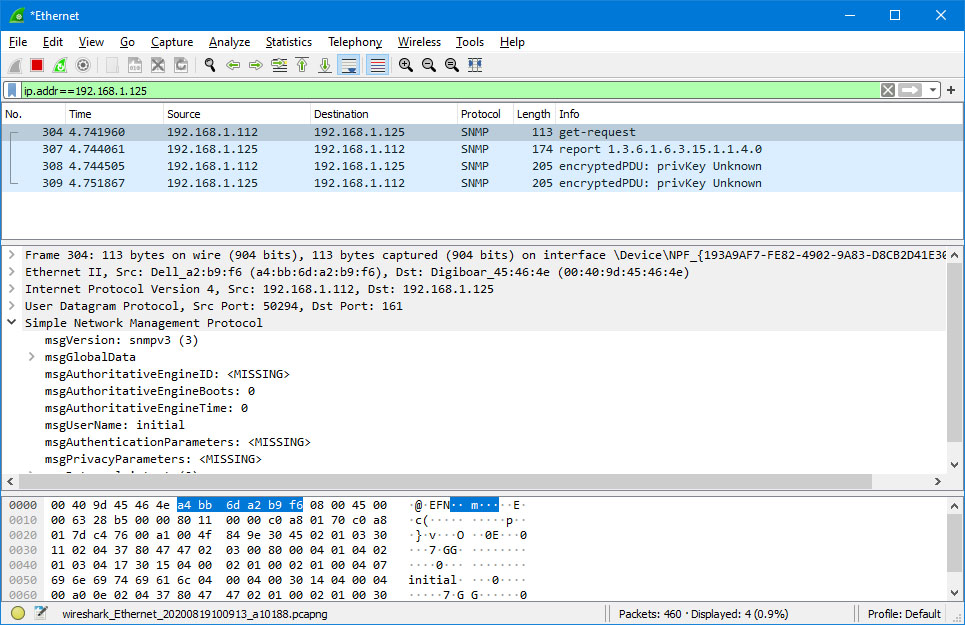
Under the Edit menu, select Preferences.
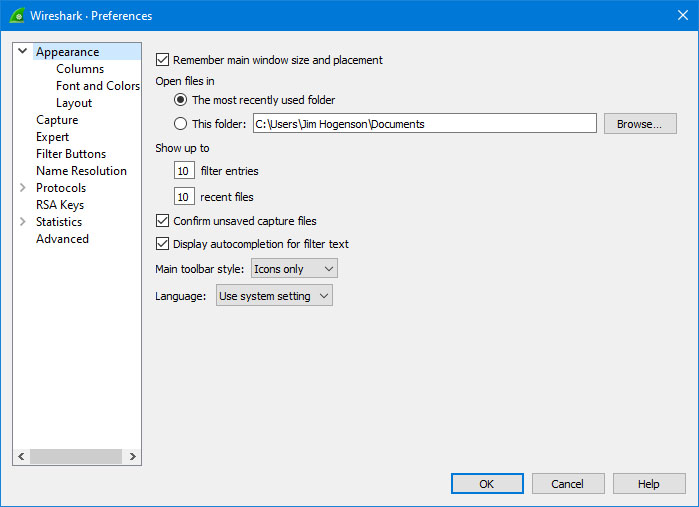
Expand the Protocols list and scroll down to SNMP. Select SNMP.
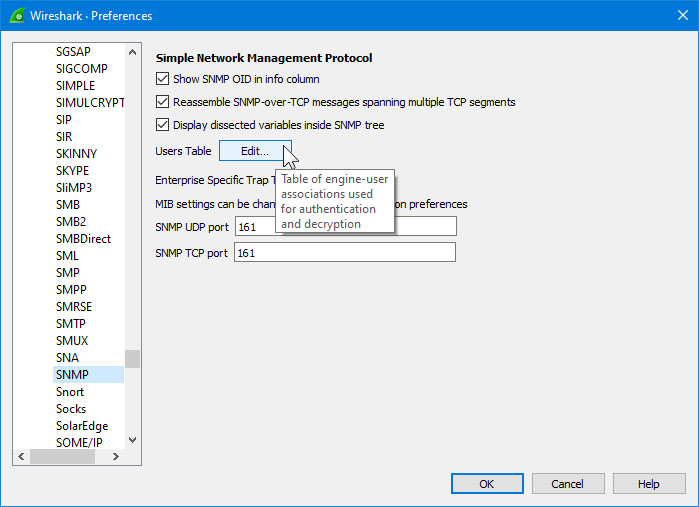
Next, click Edit (Users Table). Enter the user name and credentials being used in the Get request you wish to capture.
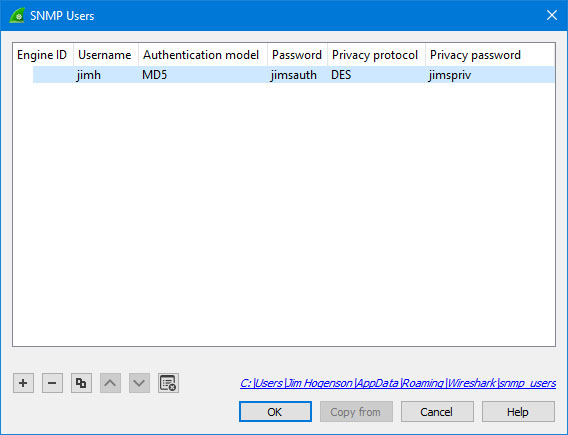
Once Wireshark has been provided with the user name and its associated credentials, Wireshark can show the full packet.
